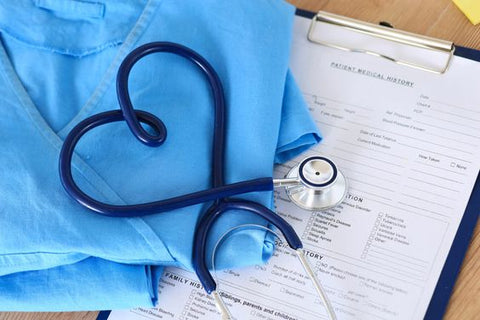Estrogens are steroid sex hormones that are mainly produced by women in the ovaries and are responsible for developing female sexual characteristics as well as other key functions in the woman's body for its proper functioning.
What types of estrogens are there?
Regarding women's health, we have different types of estrogens : estradiol is the main one in the reproductive age, estrone in postmenopause, estetrol in the fetal stage and estriol in pregnancy.
Estrogens will not only fulfill roles in the female sexual organs but will also fulfill important roles in the central nervous system, at the cardiovascular, osteomuscular, and immunological levels, as well as for the proper functioning of the metabolism.
What functions do they perform?
At the cardiovascular level, they are considered to be cardioprotective. At the vascular level, they produce vasodilation, regulate blood pressure, reduce LDL cholesterol (“bad cholesterol”) and increase HDL cholesterol (“good cholesterol”), make the heart respond better to exercise and also produce anti-inflammatory functions.
Regarding metabolism, they will be in charge of energy consumption and fat distribution. That is why women during the fertile age, when estradiol predominates, will have a distribution of fat predominantly in the buttocks and thighs, which is said to be the typical pear shape, while during menopause, where estradiol levels decrease, the increase in fat distribution occurs at the abdominal level, taking the shape of an apple.
At the level of the central nervous system, we now know that estrogens and their deficiency mainly increase the risk of both dementia and Alzheimer's, which is why today we consider that estrogens have a neuroprotective role.
At the muscular level, they increase insulin sensitivity in this type of tissue, and at the bone level, they decrease bone resorption, meaning they keep our bones strong.
With respect to the central nervous system, it will have functions on sleep, reducing the risk of having nocturnal awakenings and decreasing sleep apnea, while also improving mood.
At the skin level, estrogens increase the synthesis of both collagen and hyaluronic acid, reducing the formation of wrinkles and also improving wound healing. It also plays a role in the ocular system, reducing the risk of cataracts and macular degeneration.
And finally, they have an essential role with regard to temperature control.
But what happens when menopause arrives?
Once 12 months have passed without menstruation, we say that our menopause has already occurred. Menopause is defined as the date of the last period, but the diagnosis is made retrospectively once 12 months have passed without menstruation. This occurs due to the cessation of ovarian activity, but it does not happen suddenly. Rather, it occurs progressively, with all these hormonal and symptomatic changes that occur during this stage, and that is why we call these changes the transition to menopause until menopause finally occurs.
What hormones are involved?
We need to know that there are several hormones involved. We have FSH or follicle-stimulating hormone, which is a hormone produced at the pituitary level and is responsible for stimulating the production of estrogen at the ovarian level.
During the first stage of this perimenopause or transition to menopause, FSH will have variable concentrations, also producing variable alterations in estrogen levels. That is why in this first stage, menstrual cycles will generally have certain modifications, alterations will occur in the period, generally producing shorter cycles and more abundant and sometimes more painful menstruations, which is usually the main thing that patients comment on and is often not associated with the transition to menopause.
During the second stage, FSH will remain at high concentrations and estrogen will be reduced, and that is why in this second stage the symptoms of estrogen deficiency appear. It is during this stage, and due to ovarian exhaustion due to the cessation of ovarian activity, that estradiol will cease to be the predominant estrogen and will become estrone.
How is estrone produced?
Estrone is produced from the conversion of another hormone called androstenedione, which is released by the adrenal glands and this conversion occurs in fatty tissue. Patients experience countless changes in their bodies after the cessation of ovarian activity and the decrease in estrogen.
Symptoms that women manifest
On the one hand, we have genitourinary syndrome in menopause, which is all the changes that occur both at the genital level and at the level of the urinary system in women. These include vaginal dryness, pain during sexual intercourse, and less lubrication and hydration.
We can also have:
-Burning sensation
-Changes regarding arousal, regarding orgasm, regarding desire
-Increased urinary frequency (i.e. more desire to go to the bathroom) and urinary urgency (having to go to the bathroom faster) and women during this stage also have a higher risk of urinary incontinence.
Interesting facts
Between 60 and 80% of women will experience hot flashes during perimenopause or postmenopause. In general, hot flashes vary in intensity and will depend on each woman as well as their duration, but in general they last between 3 and 5 years; only 5% of women experience hot flashes for more than 10 years. Within the vasomotor symptoms in which we include hot flashes, there will not only be this, but also palpitations, headaches, dizziness, among others.
46% of women will report sleep disorders, many of them with insomnia when starting or stopping sleep or night sweats, and 30% of them will present both psycho-emotional and cognitive disorders, including lack of concentration, memory loss, mood swings, irritability and a tendency towards depression and anxiety. That is why it is very important to consult because patients in menopause have a higher risk of presenting mental health disorders.
In addition, with regard to cardiovascular risk, from this stage onwards cardiovascular risk increases. Women have a greater tendency. LDL cholesterol and total cholesterol increase and HDL cholesterol decreases, all the anti-inflammatory activity that estrogens had is lost and the risk of not only having heart attacks but also having strokes increases.
Finally, the protective factor that estrogens had on the bones is lost. Bone resorption increases, increasing the risk of both osteopenia and osteoporosis due to the lack of estrogen.
The metabolism, energy consumption and fat distribution also change, as I mentioned before. During this stage, the fat is mainly absorbed at the central level, that is, at the abdominal level. The woman changes from her typical pear shape to an apple shape.
But the big problem with this is that fat occurs not only at a superficial level but also at a visceral level, that is, it is in contact with the organs and it is this fat that we consider malignant and that increases the risk of cardiovascular pathology and also increases the risk of metabolic syndrome.
Regarding energy consumption, women during this stage of life have a greater tendency to gain weight, which is why it is very important to consult a nutritionist if there are major changes in body weight.
As for the skin and mucous membranes, we must know that the predominant symptom will be dryness. As well as vaginal dryness, dry eyes and nose will also occur at the mucous membrane level.
Patients at this stage will begin to have more wrinkles than they had previously and their hair will also change; it will begin to become weaker and less hydrated, falling out and not only at the capillary level, but also at the armpit and pubic level, and there are women who sometimes have increased hair on the chin and moustache.
Natural estrogens for menopause
Phytoestrogens are biological compounds derived from plants that have a chemical composition and structure very similar to estrogens, which is why they act on estrogen receptors and have numerous benefits during menopause due to the decrease in estrogen levels. This is why they are used to improve menopausal symptoms such as hot flashes.
Types of phytoestrogens
-Isoflavones: derived from soybeans, not only in the grain but also in soy milk and soy flour.
-Coumestans: we will find them in seeds as well as in soybean sprouts and in alfalfa.
-Lignans: we will find them in peas, cereals, some teas and flax seeds.
-Stilbenes such as resveratrol.
Resveratrol is a derivative found in grapes and red wine that not only has powers over estrogen receptors, but also has antioxidant and anti-inflammatory properties, which is why it is being used extensively in pro-aging medicine and also in women's medicine.
Ultimately, estrogens are essential hormones that play a crucial role in women's health and well-being. Menopause, while a natural process, brings with it changes that can affect quality of life. Phytoestrogens, while not a magic solution, can offer a natural alternative to alleviate some of the symptoms associated with this stage.
It is important to remember that every woman is unique and experiences menopause differently. Consulting a doctor or women's health specialist is essential to receive appropriate advice and treatment.
References
Nedergaard, A., Henriksen, K., Karsdal, M.A., & Christiansen, C. (2013). Menopause, estrogens and frailty. Gynecologic endocrinology: the official journal of the International Society of Gynecologic Endocrinology, 29(5), 418-423.
Hogervorst, E., Craig, J., & O'Donnell, E. (2022). Cognition and mental health in menopause: A review. Best practice & research. Clinical obstetrics & gynaecology, 81, 69–84.
Zouboulis, CC, Blume-Peytavi, U., Kosmadaki, M., Roó, E., Vexiau-Robert, D., Kerob, D., & Goldstein, SR (2022). Skin, hair and beyond: the impact of menopause. Climacteric : the journal of the International Menopause Society, 25(5), 434–442.
Fenton, A., & Panay, N. (2016). Estrogen, menopause and joints. Climacteric : the journal of the International Menopause Society, 19(2), 107–108.
Nash, Z., Al-Wattar, B.H., & Davies, M. (2022). Bone and heart health in menopause. Best practice & research. Clinical obstetrics & gynaecology, 81, 61–68.




Comments (0)
There are no comments for this article. Be the first one to leave a message!